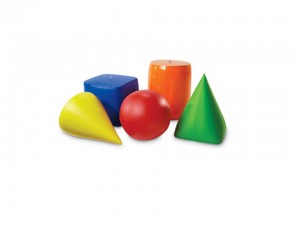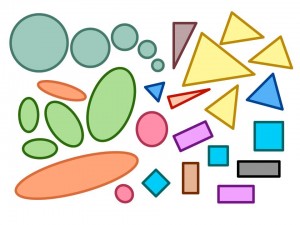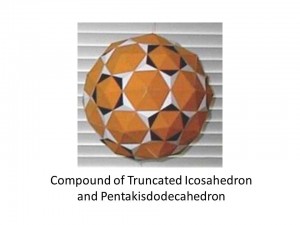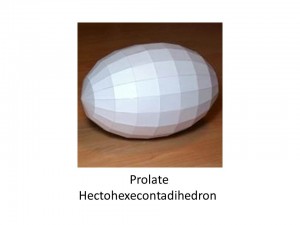Shapes, shapes, and more shapes. Circle, triangle, square, rectangle – it all starts of easy enough. Then it get a bit more complicated when you move from two dimensional to three dimensional – sphere, cylinder, pyramid, cube, prism. Then, before you know it, your tongue is in a knot, and you’re totally confused. Just what does a decagonal gyroelongated bipyramid, compound of truncated icosahedron and pentakisdodecahedron, or a prolate hectohexecontadihedron look like? It’s all in the name. The trick is understanding the language of shapes, and a little bit of Greek and Latin. For help with the Greek and Latin, check out this great table.

A lot of the elementary aged children I work with have trouble remembering the basic two dimensional shapes. When I talk about the three dimensional ones, they are totally baffled. Trying to explain these objects to them usually doesn’t help at all. They need something concrete with which to connect the names.
I recently found several websites that can help alleviate the confusion and bafflement. Some even have downloadable patterns in all kinds of color schemes for people to print, cut out, and glue together. I’ve started building the models in order to create mobiles to maintain in the department so that confused children (and adults) can see what various shapes look like in real life. That would give them something concrete to attach to all the strange names that describe the multitude of two and three dimensional shapes. I’ll start with a mobile of the two dimensional shapes. Another mobile will contain the Platonic Solids. A third mobile will be home to other three dimensional shapes that should be familiar to most people. Hopefully, this will help the kids who come to the library thinking triangles have four sides and squares have three corners get all these confusing names and shapes straightened out. The mobiles will also be something colorful and (hopefully) interesting for the children to investigate while they’re here.
In a program this spring, I hope to introduce the Platonic Solids. Participants will decorate and build their own mobiles with tetrahedrons, cubes, octahedrons, dodecahedrons, and icosahedrons. The program will help them learn the names of those basic five shapes, and they will also get the opportunity to engineer a balanced mobile. So, in one program, they will get to do some art, learn some math, do a bit of engineering, and practice fine motor skills. Hopefully, they will be enjoying themselves so much that they won’t realize that they’re actually learning “school stuff” at all!
By the way, in case you are curious, here are the shapes that have the tongue-twister names I referred to earlier:
Websites of Geometric Models:
Pepakura – tamasoft.co.jp/pepakura-en/download/polygons/index.html
Paper Models of Polyhedra (the cool one) – www.korthalsaltes.com/
Math Craft World – mathcraft.wonderhowto.com/how-to/welcome-math-craft-world-bonus-make-your-own-paper-polyhedra-0130467/
Net Building program: dxf2papercraft.sourceforge.net/
Math is Fun: www.mathsisfun.com/geometry/polyhedron.html
Animated Polyhedra (Really cool!!): www.mathsisfun.com/geometry/polyhedron-models.html
Polyhedra Names: www.georgehart.com/virtual-polyhedra/naming.html
Kids’ Math Games: www.kidsmathgamesonline.com/facts/geometry/3dpolyhedronshapes.html
Types of Polyhedra: www.ditutor.com/solid_gometry/types_polyhedra.html
Sparklebox PDF (copyrighted): www.northfold.lancsngfl.ac.uk/download/file/shapes%20info.pdf
Naming polyhedra: www.geom.uiuc.edu/~teach95/kt95/KTL12s.html
Greek prefixes for geometry: mrshclassblog.wikispaces.com/file/view/math+prefixes.doc.pdf
Collection of Greek and Latin prefixes, suffixes, and curiosities: phrontistery.info/numbers.html








Leave A Comment